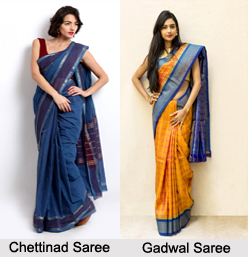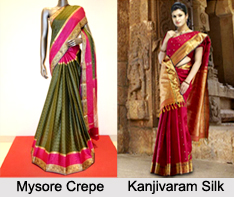 Sarees of South India are the representation of several cultures that exist here with the Tamil, Kerala and Sinhalese societies standing out most strongly. Today, sarees of South India have earned the epithet of one of India"s major saree-weaving regions by producing considerable quantities of rural, peasant and urban middle-class sarees in silk, cotton, rayon and polyester. The colourful festivities of India gets a pan view of women folk clad in these ornamented, vast coloured sarees. The handloom cooperatives of Tamil Nadu sell sarees throughout India keeping in mind the latest trends and designs. This is one of the reasons behind the fact that many traditional designs from different south Indian localities have been incorporated into the repertoire of other areas. Though these amalgamations of different styles and materials have made it impossible to differentiate the actual origin of the textile of a saree from the other, some sarees possess their own typical styles that are easily distinguishable.
Sarees of South India are the representation of several cultures that exist here with the Tamil, Kerala and Sinhalese societies standing out most strongly. Today, sarees of South India have earned the epithet of one of India"s major saree-weaving regions by producing considerable quantities of rural, peasant and urban middle-class sarees in silk, cotton, rayon and polyester. The colourful festivities of India gets a pan view of women folk clad in these ornamented, vast coloured sarees. The handloom cooperatives of Tamil Nadu sell sarees throughout India keeping in mind the latest trends and designs. This is one of the reasons behind the fact that many traditional designs from different south Indian localities have been incorporated into the repertoire of other areas. Though these amalgamations of different styles and materials have made it impossible to differentiate the actual origin of the textile of a saree from the other, some sarees possess their own typical styles that are easily distinguishable.
Weaving of South Indian Sarees
South India is the centre where mulberry silk with Karnataka alone accounting for about 60 percent. Sericulture is practiced mainly in the southern part of the state, in Bengaluru, Kolar, Tumkur, Mysore and Mandya districts, although it is now expanding northwards. Most Tamil and southern Andhra Pradesh weavers belong to either the Devanga (weaver) or Saalikan (Saliyar) castes. Apart from the Saaliya, Jaada (Lingayat) and Neekaara weaving communities, men and women of other non-traditional communities are also involved in weaving south Indian sarees.
Designs of South Indian Sarees
There are 2 basic types of designs in the traditional south Indian sarees that are distinguished by their borders. The traditional sarees of south India include those with noticeably wide borders of contrasting colour to the field. These sarees are created through a variety of different weaving and dyeing techniques. Besides these the sarees with very narrow borders, often less than 1 inch wide are also made. The latter types of sarees are created solely through supplementary-warp patterning. In both styles the border extends the full warp length of the saree and forms part of the end piece, which is usually long.
Different Types of Saree in South India
The sarees of south India includes the Chettinad Sarees, Gadwal Sarees, Kanjeevaram Sarees, Konrad Sarees, Mysore Silk Sarees and Pochampally Sarees that are called the traditional sarees of this region.
•Konrad Sarees: The Konrad or the temple saree is considered to be one of the coveted sarees of this region and is also a specialty item from Tamil Nadu. The sarees have secured a distinct position among the south Indian women due to their simple yet classy and ethnic look that go well with any occasion.
•Chettinad Sarees: Another most distinguishable saree of South India is Chettinad sarees. This saree is named after a small town in southern Tamil Nadu state. The weavers create traditional designs on Chettinad cotton and silk sarees in contemporary colour.
•Gadwal Sarees: Gadwal sarees of South India are traditional sarees and are preferred by the women of this region. The weavers take the designs of the sarees from south-eastern temple structures and are worn in religious occasions and festivals.
•Kanjeevaram Sarees: One of the most sought after sarees of South India is Kanjeevaram silk that are widely used among the women of Tamil Nadu. These sarees are preferred because of the quality material and affluent traditional look. This sarees have secured the most preferred corner in the heart of the south Indian women and are worn in weddings and religious occasions.
•Mysore Silk Sarees: Apart from these traditional and uniquely weaved sarees, south India is also the centre of Mysore silk sarees. These sarees are preferred all over the world for their fine form, vibrant colours and rich and traditional appeal. These sarees are woven with the purest forms of silk.
•Pochampally Sarees: On the other hand the weavers of Pochampalli sarees derive the raw materials from the Pochampalli co-operative society. The weavers are inventing new ways of combining designs and techniques to enhance the glitz of the sarees. The traditional sarees include the designs of parrot, elephant and diamond and flower motifs.
The sarees of south India have age long tradition and the weavers of different communities amalgamate different designs, traditional and modern, according to the demand of the modern people. They define style, personality, not fashion, that comes and goes.





















